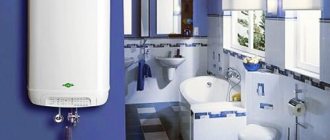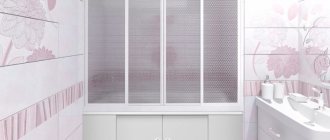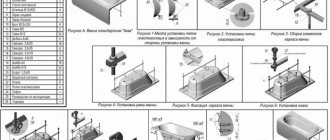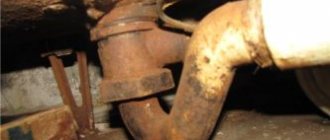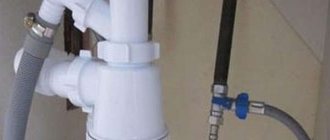The modern plumbing industry today offers a large number of different innovations that are designed to ensure comfort when using plumbing devices. One of these innovations is the overflow drain system, which is also called a bathtub trim. In the original versions, this system consisted of two separate devices, a tube for the overflow hole and a siphon, which were mounted on the bathtub independently of each other and constituted a bulky system.
Later, they decided to combine both of these devices into one, which, due to its compactness, immediately gained popularity and positive reviews not only from professional plumbers, but also from ordinary users. Thanks to its design, installing or replacing the bathtub trim has become much easier and does not require special skills or complex tools. The system simultaneously serves to ensure the outflow of liquid and control the filling level of the bath. In this article we will analyze in detail the principle of operation of the system, its design, materials for manufacturing, and you will also have the opportunity to watch the video at the end of the article, which will answer your questions.
Why do you need a bathtub piping and how does it work?
The name “drain-overflow” is due to two holes in the bathtub fitting:
- upper, which is necessary to minimize water overflow;
- the lower one through which drainage occurs.
A bathtub fitting is a device similar to a regular siphon, the overflow neck of which is equipped with a rotation lever connected by a cable to a similar mechanism in the drain neck. Turning the rotation lever increases or decreases the tension of the cable, and the mechanism in the drain neck is activated, raising or lowering the plug. This eliminates the need to manually install and remove the plug.
Bathtub trim option
Classification of bathtub trims
Bath fittings are classified according to two main principles:
- by design features;
- according to materials. The drain and overflow can be metal or plastic.
Metal or plastic - which is better?
The metal device can be made of stainless steel, brass, copper with a chrome surface. Products of this type are distinguished by their reliability, durability and long service life, but are characterized by a whole list of disadvantages, the main of which are:
- high prices;
- the need for precise adjustment of all parts of the system, which makes installation difficult;
- accumulation of debris and fatty deposits in the system, which requires regular cleaning with chemicals.
Metal bathtub trim
Advantages of plastic devices
High-quality plastic bathtub piping is much cheaper than metal, but is not inferior to it in reliability and, with careful use, durability. The plastic intended for the manufacture of such products is not subject to corrosion and has the following characteristics:
- high strength;
- durability;
- resistance to high temperatures and aggressive environments;
- the ability not to accumulate dirt and fat deposits.
If necessary, the plastic model can be easily replaced without much financial loss.
Bathtub trim option
Do-it-yourself harness installation
Now we will look at how to install a bathtub trim yourself. The structure of the work is as follows:
- It is necessary to disassemble the old harness. There are generally no problems with the plastic strapping. If there is a problem with unwinding, then you can simply break it and take it out. But sometimes difficulties arise with metal strapping; sometimes, in order to remove it, it is necessary to use a grinder.
- Next, you need to check the presence of all gaskets and other elements on the new harness.
- We disconnect all the grates from the drain and overflow pipes.
- Since the bathtub outlet is located low, its installation is quite problematic and for this it is necessary to carry out work in a not very comfortable position. In order to facilitate this task, we connect the siphon to the sewer pipe, and then install the bath itself. But this method is used if the bathtub is made from lightweight raw materials. If the bathtub is made of cast iron, then this method is not recommended, since installation will be a little problematic and not everyone can do the installation first.
- A receiving pipe is placed on the outside, onto which a gasket made of rubber is put on.
- We build a grate into the bathtub itself and secure the entire structure using a coupling bolt. It is easiest to do this work with an assistant, since someone will be able to press the pipe, and the other will hold the neck while twisting it.
- There is no need to put in a lot of effort during installation, since the parts of the device may not withstand the load and become damaged, and as a result you will have to buy a new one.
- The overflow pipe is installed in the same way. Just before starting installation, you should slightly deform (stretch) the corrugated tube in order to easily put it on the pipe.
- If such a situation arises, such as the fact that the product contains two gaskets, it is necessary to strengthen them from the outside in order to avoid leakage in this place. An auxiliary element can be silicone sealant.
- Also, in order to prevent stagnation of liquid, which can subsequently cause an unpleasant odor, it is recommended to install the piping above the sewer level. In turn, it is also necessary to think about ensuring accessibility to the system, so that if a breakdown occurs, it can be easily fixed.
It will be interesting: We create a water leakage control system using improvised means
In conclusion, we can say that at the moment there are many types of harnesses. It is not possible to install a pipe made of plastic on your own. And if your choice is a semi-automatic harness, then it is best to trust a specialist to install them, since it will be much more difficult to install it yourself. When carrying out installation, do not forget that it must be installed conscientiously and accurately. Therefore, after installation, you should carefully check everything to be sure of the reliability of this design.[art_yt id=”a7dUGPwJ45E” wvideo=”640" hvideo=”360" position=”center” urlvideo=”https://www.youtube.com /watch?v=a7dUGPwJ45E” namevideo=”Bathtub trim” desc=”In this video I’ll talk about the McAlpine overflow drain. In my opinion, this bathtub trim is the most reliable that exists today. The bathtub trim is often hidden in niches and in general is in a hard-to-reach place.” durationmin=”16" durationsec=”06" upld=”2015-06-10" tmburl=”https://i.ytimg.com/vi/a7dUGPwJ45E/maxresdefault.jpg” thumbnailwidth=”1280" thumbnailheight=”720" ]
Currently reading
- Materials of standard baths and their volumes in liters
- Selecting and installing an important frame for acrylic bathtubs
- If you are interested in siphons for cast iron bathtubs, then here you go
- Modern bath and kitchen faucets Grosser
Types of bath trim
Having studied some of the subtleties of the question of what a bathtub piping is, you can familiarize yourself with the design features of different models. Three types of products are produced:
- A universal model with a stopper on a chain, designed for any type of bathtub - acrylic, steel, cast iron. This device, consisting of a siphon, a drain neck with a metal cover for the lid, an overflow neck with a cover of the same type and a flexible hose connecting the drain neck with the overflow by pulling it onto a fitting or using nuts, is characterized by its simple design and low cost.
- A semi-automatic device, the characteristic feature of which is a rotary lever connected by a cable to the plug. Depending on the direction of rotation of this part, the drain opens or closes.
- The automatic bath fitting is easy to use and has no fragile parts. You can close or open the drain by lightly pressing the plug, which is easy to do even with your heel. Very convenient are the machines, which provide the ability to draw water and open the drain in a semi-automatic mode. There is no need to install a mixer with such a drain-overflow system.
There are specially designed models for non-standard bathtubs and custom-made containers.
Manufacturers overview
The Internet contains a large amount of information on how to choose a good model.
Popular manufacturers of bathtub surrounds:
- "Alcaplast" (Czech Republic);
- "Vega" (Italy);
- "Grohe" (Switzerland);
- "Kaiser" (Germany).
Plastic drain and overflow systems and “Vega” are of high quality. also produces high-quality products, but with high sales costs. manufactures good metal harnesses and gives a ten-year guarantee for its products, and has launched the production of automatic type harnesses.
We invite you to familiarize yourself with Flexible connection for a mixer: selection and installation of a bellows connection for water
Disadvantages of semi-automatic and automatic devices
In addition to numerous advantages, including convenience and ease of use, semi-automatic and automatic devices have a number of disadvantages:
- semi-automatic machines made of plastic are characterized by fragility of structural elements that can break under intense mechanical pressure on the lever or strong water pressure. It is almost impossible to repair such a breakdown - you will have to buy a new bathtub fitting;
- To lift the plug in a semi-automatic device, a cable is used that connects the drain and overflow blocks, and to close or open the drain hole, you need to turn the overflow cap. In inexpensive products, the cable quickly wears out and becomes unusable, so it is preferable to choose products from German brands;
- a characteristic feature of the machines is the hole under the plug, which often causes blockages in the drain neck;
- plastic machines, especially cheap models, are unreliable, so it is better to purchase products made of metal.
Types of structures
Such systems are available in several types: traditional drain, semi-automatic and automatic system. Let's consider the design features and the principle of their operation.
Classical
The traditional system is a design familiar to many, which consists of a drain and overflow holes protected by a mesh. To fill the bathtub, the drain is plugged with a stopper. The advantage of such a system is the simplicity of its design: it is easy to install and disassemble in case of blockage. Another plus is that the large diameter of the overflow receiver is guaranteed to prevent the bathtub from overflowing, even if the water is drawn very intensively. The drain funnel also has a large diameter, ensuring the rapid release of a significant volume of water into the sewer. The disadvantages include a simple design, which does not always harmonize with modern bathroom renovations.
The procedure for installing a simple drain is as follows:
- Dismantling the old device, cleaning seats where dirt often accumulates.
- Installing the lower drain pipe. A rubber gasket is used to seal the connection.
- Installation of the overflow pipe is carried out according to a similar scheme.
- Siphon connection. A cone-shaped plastic gasket is used to seal the connection of the pipes.
- The siphon and overflow pipe are connected using a flexible hose.
- The siphon is connected to the sewer using a corrugated pipe.
Advice! For better sealing, it is recommended to additionally apply a thin layer of silicone sealant to all rubber seals.
Semi-automatic
This type of system is equipped with a manual control unit mounted on the overflow hole and consisting of a rotary knob or ring that activates the adjustment cable. In turn, the second end of the cable is connected to a drain plug-valve, which, depending on the position of the handle, rises to drain water or lowers to fill the bath.
The advantages of this device include the ability to open the drain without putting your hand in the water, and a variety of design solutions. Also, the advantages include a modern and stylish design. One of the disadvantages is the fact that the holes in the valve plug are often clogged, which reduces the intensity of water flow. Also, when taking a shower with the plug raised, there is a risk of damaging the valve, so it is recommended to choose durable products.
The installation of a semi-automatic design is slightly different from the installation of a conventional siphon, since the drain pipe on which the lifting mechanism for the plug is installed is already connected by a flexible pipe to the overflow pipe on which the control unit is installed. Also connected to this structure is a cable, with the help of which the drain plug-valve is raised or lowered. The cable is located both inside and outside the overflow tube.
The drain and overflow pipes of the semi-automatic system are connected to each other
The installation procedure is as follows:
- A siphon is connected to the drain pipe. Cone gaskets are already installed on the structure, so the individual elements are simply connected and the fixing nut is tightened by hand.
- Next, the outlet pipe is connected to the siphon in the same way.
Siphon assembly. - Next, the assembled siphon is placed under the bathtub and placed under the drain hole. A butterfly gasket is installed to prevent leaks and contact of metal elements with the bathtub bowl.
- The protective grille is screwed on using a screw.
Installation of the grille. - The overflow pipe is connected in the same way.
- A rotary knob is installed on the control unit.
Installation of the handle. - After this, a valve plug is connected to the drain pipe. For its installation, a groove is provided in the fixing screw.
- Turning the knob checks the functionality of the system.
Valve installation.
The main breakdowns of the semi-automatic drain and overflow system:
- Mechanical damage to the plug. Most often, replacement of the valve is required, since when the stem is bent, the plug no longer fits tightly into its seat and does not block the drain.
- Broken cable. During operation, the control cable wears out and breaks. To change it, you need to remove the decorative covers located on the control units and install a new cable.
Machine
An automatic bathtub drain and overflow is a spring-loaded valve plug that closes the drain hole when you simply press it. When pressed again, the plug rises and opens a hole for draining water. This system is often called “click-clack”.
The advantages of automatic draining include the following factors:
- Relatively simple design, minimum of collapsible elements.
- Easy to use.
- Modern design of external elements.
Among the disadvantages, frequent breakdowns of the plug retainer are noted, so you need to choose high-quality products from well-known manufacturers. Another disadvantage of the automatic design is the small diameter of the drain slot, so the water flows out quite slowly.
The installation technology for an automatic model is completely similar to the installation of a semi-automatic model. The only difference is that the cover on the overflow performs only decorative functions.
Note! To clean a clogged drain hole, just unscrew the button plug: it is attached to a screw rod.
The most common failure of an auto drain is failure of the spring and plug retainer. In this case, a new mechanism from the same manufacturer is purchased and a replacement is made.
How to choose the right drain and overflow
When choosing a frame, you need to take into account the material from which the bathtub is made and the thickness of its walls. For example, thin-walled steel containers require a drain and overflow of a special design.
An equally significant factor when purchasing is the appearance of the product. Our photo gallery presents models made of white plastic or polypropylene, non-ferrous metals with a glossy and matte chrome surface. If desired, you can choose a decorative metal frame in silver, platinum, gold, equipped with forged curly legs. The drain and overflow made of ferrous metal has high performance characteristics, but is completely unpresentable in appearance. It can be disguised with a special removable screen.
Installing a bathtub trim
On our website in the gallery there are models of any design for bathtubs of all types. The reliability and durability of mechanisms often depends on parts that can break, so an easy-to-use siphon with a small number of parts is ideal. It’s up to the buyers to decide whether it’s worth chasing fashion by buying cutting-edge sophisticated devices.
How is the installation done?
Any master can easily install the universal system. It is better to entrust the installation of complex automatic and semi-automatic systems to professional builders.
To carry out the work you need:
- purchasing a drainage system that meets the required parameters;
- metal cutting knife;
- Screwdriver Set;
- waterproof sealant.
The installation of a bathroom piping is carried out in several stages.
Removing old trim
Before you begin connecting a new device, you should clean the surface of the bath and remove the equipment that requires replacement.
Removing a failed plastic system is quite simple. It can be easily untwisted. To remove metal elements you will need a grinder.
Important!
It is often difficult to crawl under the bathtub with an angle grinder to remove the structure. For ease of removal, turn the bathtub upside down.

